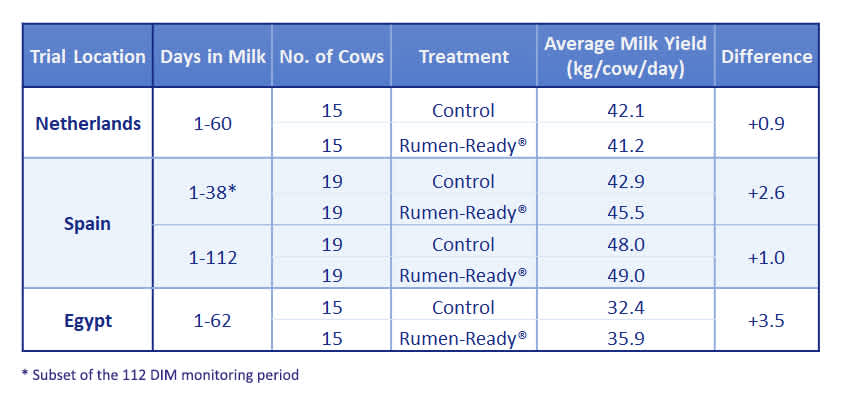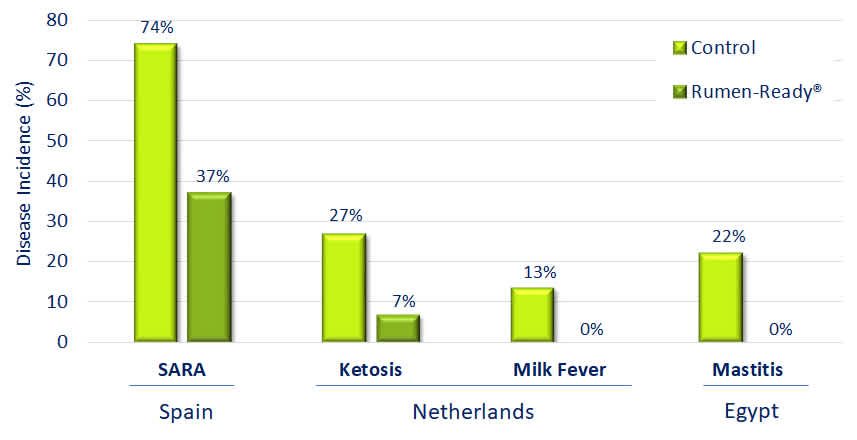The benefits of Rumen-Ready®
The benefits of Rumen-Ready ® for transition dairy cows has been confirmed in field trials performed in several different countries.

After feeding Rumen-Ready® for just three weeks before calving, milk performance was improved in all trials (Table 1) and animals were more resistant to the different challenges they faced during the transition phase (Figure 1). This highlights the true value of magnesium butyrate in terms of redeveloping the rumen wall surface area before lactation begins. Furthermore, Rumen-Ready® is also a highly bioavailable source of magnesium.
In the Netherlands, a field trial was performed with multiparous dairy cows (n = 15) that after calving had a slow build up in concentrate level. This feeding strategy results in a higher risk of ketosis in the herd rather than subacute ruminal acidosis (SARA). Under these conditions, Rumen-Ready® improved milk production by 0.9 kg/cow/day during the first 60 days in milk (DIM), and benefits were also seen in terms of animal health. Compared to the control group, during early lactation Rumen-Ready® decreased the incidence of both ketosis (control, 27 %; Rumen-Ready®, 7 %) and milk fever (control, 13 %; Rumen-Ready®, 0 %). Furthermore, the Rumen-Ready® group had an increased colostrum quantity (+16 %), along with improved colostrum quality in terms of IgG content.

TABLE 1: RUMEN-READY IMPROVES MILK YIELD
The second field trial was performed in Spain. In contrast to the feeding strategy in the Dutch trial, a total mixed ration was fed after calving. The lactation ration had a high level of concentrates, up to 15 kg per cow. This feeding strategy is well known to increase the risk of SARA. The trial used both primiparous and multiparous cows, with parity matched in the study groups (n = 19). Colostrum quantity was increased by 32 % by Rumen-Ready®. The milk yield also increased by 2.6 kg/cow/day during the first 38 DIM. On average, the milk yield increased by 1.0 kg/cow/day in the first 112 DIM. A significant increase of 0.3 % fat content in the milk was also observed. This was clearly linked to improved rumen pH, as earlier rumen redevelopment using Rumen-Ready® decreased the SARA incidence up to 50 %.

FIGURE 1: RUMEN-READY IMPROVES COW HEALTH
As well as decreasing SARA risk, rumen pH is key to improving rumen function & feed efficiency. In a trial performed in Chile, the effect of Rumen-Ready® on the rumen pH of dairy cows (n = 4) was monitored using rumen bolus pH devices during the first 60 DIM. After feeding Rumen-Ready® for three weeks before calving, the average daily pH (control, 6.4; Rumen-Ready®, 6.7) and the minimum pH (control, 5.4; Rumen-Ready®, 5.7) was increased. Rumen-Ready® also decreased the time that the rumen pH was less than 5.8 (control, 34 min/day; Rumen-Ready®, 2 min/day), which is a key defining characteristic of SARA.
Dairy cows can face different stressors per country, such as heat stress. This was the case in a field trial that was performed in Egypt (n = 18). Under these trial conditions, the Rumen-Ready® group produced on average 3.5 kg/cow/day more milk during the first 62 DIM compared to the control group. Incidence of clinical mastitis, which was an issue on the trial farm, was also decreased from 22 % in the control group to 0 % in the Rumen-Ready® group.
In conclusion, Rumen-Ready® is a unique solution to improve milk performance, health and robustness of transition cows. Feeding Rumen-Ready® for just three weeks prior to calving until calving delivers a broad range of benefits. This results in a high return on investment due to increased performance as well as decreased losses.